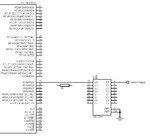Prakash12345
Junior Member level 2
Hi,
I want to interface sensors to pic micro-controller(PIC18F87K22). For protection buffer(74HC541) is used in between them. Sink current of PORTH pins are 2mA. Other ports are dedicated to various operation. Buffer output current is +/- 35mA. Is this is a problem?
Resistor connected to serially will rectify sink current problem.

I want to interface sensors to pic micro-controller(PIC18F87K22). For protection buffer(74HC541) is used in between them. Sink current of PORTH pins are 2mA. Other ports are dedicated to various operation. Buffer output current is +/- 35mA. Is this is a problem?
Resistor connected to serially will rectify sink current problem.


